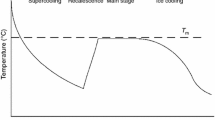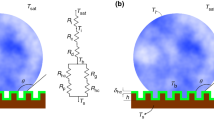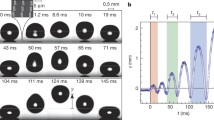Abstract
The condensation heat transfer efficiencies of superhydrophobic surfaces that have ∼160° contact angle under atmospheric conditions were investigated experimentally. The departing diameter and the contact angle hysteresis of droplets were measured by capturing front and tilted side views of condensation phenomena with a high speed camera and an endoscope, respectively. Condensation behaviors on the surface were observed at the micro-scale using an Environmental scanning electron microscope (ESEM). Apparently-spherical droplets formed at very low heat flux q″ ∼20 kW/m2 but hemispherical droplets formed at high q″ ∼440 kW/m2. At high q″, heat transfer coefficients were lower on the superhydrophobic surface than on a hydrophobic surface although the superhydrophobic surface is water repellent so droplets roll off. The results of contact angle hysteresis and ESEM image revealed that the reduced heat transfer of the surface can be attributed to the large size of departing droplets caused by adhesive condensed droplets at nucleation sites. The results suggest that the effect of q″ or degree of sub-cooling of a condensation wall determine the droplet shape, which is closely related to removal rates of condensates and finally to the heat transfer coefficient.
Similar content being viewed by others
References
P. Nag, Power plant engineering, Tata McGraw-Hill Education (2002).
R. W. Bonner, Dropwise condensation life testing of self assembled monolayers, 14th International Heat Transfer Conference (2010) 221–226.
L. Chen, S. Liang, R. Yan, Y. Cheng, X. Huai and S. Chen, n-Octadecanethiol self-assembled monolayer coating with microscopic roughness for dropwise condensation of steam, Journal of Thermal Science, 18 (2009) 160–165.
E. Citakoglu and J. Rose, Dropwise condensation—some factors influencing the validity of heat-transfer measurements, International Journal of Heat and Mass Transfer, 11 (1968) 523–537.
A. Das, H. Kilty, P. Marto, G. Andeen and A. Kumar, The use of an organic self-assembled monolayer coating to promote dropwise condensation of steam on horizontal tubes, Journal of Heat Transfer, 122 (2000) 278–286.
C. A. Depew and R. L. Reisbig, Vapor condensation on a horizontal tube using teflon to promote dropwise condensation, Industrial & Engineering Chemistry Process Design and Development, 3 (1964) 365–369.
X. Ma, J. Chen, D. Xu, J. Lin, C. Ren and Z. Long, Influence of processing conditions of polymer film on dropwise condensation heat transfer, International Journal of Heat and Mass Transfer, 45 (2002) 3405–3411.
G. A. O’neill and J. Westwater, Dropwise condensation of steam on electroplated silver surfaces, International Journal of Heat and Mass Transfer, 27 (1984) 1539–1549.
J. Rose, On the mechanism of dropwise condensation, International Journal of Heat and Mass Transfer, 10 (1967) 755–762.
J. Rose, Dropwise condensation theory and experiment: a review, Proceedings of the Institution of Mechanical Engineers, Part A: Journal of Power and Energy, 216 (2002) 115–128.
E. Schmidt, W. Schurig and W. Sellschopp, Versuche über die Kondensation von Wasserdampf in Film-und Tropfenform, Technische Mechanik und Thermodynamik, 1 (1930) 53–63.
D. Tanner, D. Pope, C. Potter and D. West, Heat transfer in dropwise condensation at low steam pressures in the absence and presence of non-condensable gas, International Journal of Heat and Mass Transfer, 11 (1968) 181–190.
D. Tanner, C. Potter, D. Pope and D. West, Heat transfer in dropwise condensation—Part I The effects of heat flux, steam velocity and non-condensable gas concentration, International Journal of Heat and Mass Transfer, 8 (1965) 419–426.
Y. Utaka, A. Saito, H. Ishikawa and H. Yanagida, Study on dropwise condensation curves: Dropwise to filmwise transition of propylene glycol, ethylene glycol and glycerol vapors on a copper surface using a monolayer type promoter (Part 1), Bulletin of JSME, 29 (1986) 4228–4234.
S. Vemuri, K. Kim, B. Wood, S. Govindaraju and T. Bell, Long term testing for dropwise condensation using selfassembled monolayer coatings of n-octadecyl mercaptan, Applied Thermal Engineering, 26 (2006) 421–429.
Q. Zhao and B. Burnside, Dropwise condensation of steam on ion implanted condenser surfaces, Heat Recovery Systems and CHP, 14 (1994) 525–534.
H. Ban and G. Son, Numerical simulation of droplet evaporation between two circular plates, Journal of Mechanical Science and Technology, 29 (2015) 2401–2407.
Y. Yoon, Y. Jo and H.-S. Kim, Experimental investigation of liquid water droplet removal in a simulated polymer electrolyte membrane fuel cell gas channel with gas diffusion layer characteristics, Journal of Mechanical Science and Technology, 28 (2014) 5221–5230.
C. Dorrer and J. Rühe, Wetting of silicon nanograss: from superhydrophilic to superhydrophobic surfaces, Advanced Materials, 20 (2008) 159–163.
X.-M. Li, D. Reinhoudt and M. Crego-Calama, What do we need for a superhydrophobic surface? A review on the recent progress in the preparation of superhydrophobic surfaces, Chemical Society Reviews, 36 (2007) 1350–1368.
K. Rykaczewski, A. T. Paxson, S. Anand, X. Chen, Z. Wang and K. K. Varanasi, Multimode multidrop serial coalescence effects during condensation on hierarchical superhydrophobic surfaces, Langmuir, 29 (2013) 881–891.
I. C. Bang and J. H. Jeong, Nanotechnology for advanced nuclear thermal-hydraulics and safety, Nuclear Engineering and Technology, 43 (2011) 217–242.
R. Blossey, Self-cleaning surfaces—virtual realities, Nature Materials, 2 (2003) 301–306.
C. Graham and P. Griffith, Drop size distributions and heat transfer in dropwise condensation, International Journal of Heat and Mass Transfer, 16 (1973) 337–346.
C. Neinhuis and W. Barthlott, Characterization and distribution of water-repellent, self-cleaning plant surfaces, Annals of Botany, 79 (1997) 667–677.
D. Öner and T. J. McCarthy, Ultrahydrophobic surfaces. Effects of topography length scales on wettability, Langmuir, 16 (2000) 7777–7782.
Z. Yoshimitsu, A. Nakajima, T. Watanabe and K. Hashimoto, Effects of surface structure on the hydrophobicity and sliding behavior of water droplets, Langmuir, 18 (2002) 5818–5822.
C.-H. Chen et al., Dropwise condensation on superhydrophobic surfaces with two-tier roughness, Applied Physics Letters, 90 (2007) 173108.
J. B. Boreyko and C.-H. Chen, Self-propelled dropwise condensate on superhydrophobic surfaces, Physical Review Letters, 103 (2009) 184501.
C. Dietz, K. Rykaczewski, A. Fedorov and Y. Joshi, Visualization of droplet departure on a superhydrophobic surface and implications to heat transfer enhancement during dropwise condensation, Applied Physics Letters, 97 (2010) 033104.
N. Miljkovic et al., Jumping-droplet-enhanced condensation on scalable superhydrophobic nanostructured surfaces, Nano Letters, 13 (2012) 179–187.
Y.-T. Cheng and D. E. Rodak, Is the lotus leaf superhydrophobic?, Applied Physics Letters, 86 (2005) 144101.
R. Narhe and D. Beysens, Water condensation on a superhydrophobic spike surface, EPL (Europhysics Letters), 75 (2006) 98.
R. Narhe and D. Beysens, Growth dynamics of water drops on a square-pattern rough hydrophobic surface, Langmuir, 23 (2007) 6486–6489.
K. W. Kim, S. C. Do, J. S. Ko and J. H. Jeong, Observation of water condensate on hydrophobic micro textured surfaces, Heat and Mass Transfer, 49 (2013) 955–962.
A. Cassie and S. Baxter, Wettability of porous surfaces, Transactions of the Faraday Society, 40 (1944) 546–551.
R. N. Wenzel, Resistance of solid surfaces to wetting by water, Industrial & Engineering Chemistry, 28 (1936) 988–994.
R. Enright, N. Miljkovic, A. Al-Obeidi, C. V. Thompson and E. N. Wang, Condensation on superhydrophobic surfaces: The role of local energy barriers and structure length scale, Langmuir, 28 (2012) 14424–14432.
N. Miljkovic, R. Enright and E. N. Wang, Effect of droplet morphology on growth dynamics and heat transfer during condensation on superhydrophobic nanostructured surfaces, Acs Nano, 6 (2012) 1776–1785.
C. Lee, H. Kim, H. S. Ahn, M. H. Kim and J. Kim, Micro/ nanostructure evolution of zircaloy surface using anodization technique: Application to nuclear fuel cladding modification, Applied Surface Science, 258 (2012) 8724–8731.
R. Hannemann and B. Mikic, An analysis of the effect of surface thermal conductivity on the rate of heat transfer in dropwise condensation, International Journal of Heat and Mass Transfer, 19 (1976) 1299–1307.
E. Dussan and R. T.-P. Chow, On the ability of drops or bubbles to stick to non-horizontal surfaces of solids, Journal of Fluid Mechanics, 137 (1983) 1–29.
A. ElSherbini and A. Jacobi, Liquid drops on vertical and inclined surfaces: I. An experimental study of drop geometry, Journal of Colloid and Interface Science, 273 (2004) 556–565.
C. Furmidge, Studies at phase interfaces. I. The sliding of liquid drops on solid surfaces and a theory for spray retention, Journal of Colloid Science, 17 (1962) 309–324.
A. Lafuma and D. Quéré, Superhydrophobic states, Nature Materials, 2 (2003) 457–460.
Author information
Authors and Affiliations
Corresponding author
Additional information
Recommended by Associate Editor Dong Geun Lee
Hyun Sun Park has received his Ph.D. in 1995 from the University of Wisconsin at Madison, USA. He is a nuclear engineer with research interests centered primarily in thermal hydraulics, and multiphase flow. He especially emphasized the areas of reactor operation, reactor safety and risk assessment for nuclear safety and accident analysis as well as fundamental and industrial applications of multiphase phenomena. He is currently a Research Professor in POSTECH, Korea.
Kyung Won Hwang has received his master of environmental science and engineering at POSTECH, Korea in 2012. He is a Ph.D. candidate of mechanical engineering at POSTECH and has research interests with phase change heat transfer, especially for flow boiling in a tube, filmwise condensation in a tube and dropwise condensation heat transfer.
Rights and permissions
About this article
Cite this article
Hwang, K.W., Kim, D., Jo, H. et al. Effects of heat flux on dropwise condensation on a superhydrophobic surface. J Mech Sci Technol 30, 2141–2149 (2016). https://doi.org/10.1007/s12206-016-0421-1
Received:
Revised:
Accepted:
Published:
Issue Date:
DOI: https://doi.org/10.1007/s12206-016-0421-1




